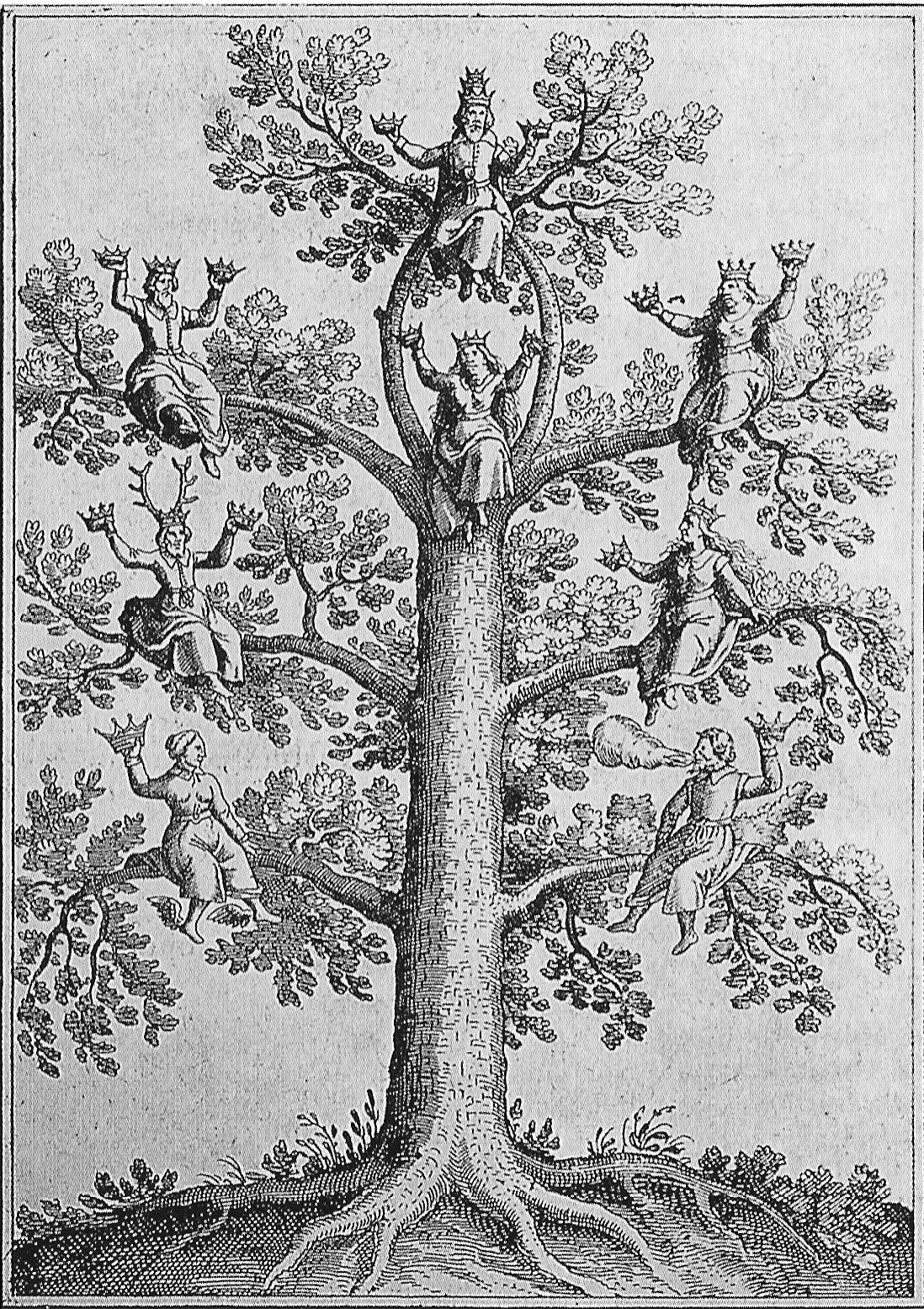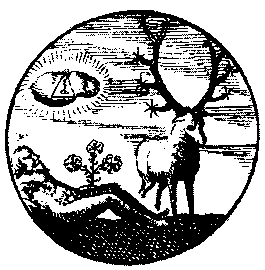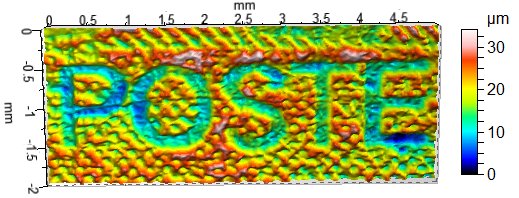|
Lucas Jennis
Lucas Jennis (1590–1630) was a German engraver. He was the leading publisher of alchemical works of his time. Life Jennis was born to Lucas Jennis the Elder in Frankfurt. His father was a wealthy goldsmith, jeweller, and engraver who had fled persecution in Brussels. Jennis’ father died in 1606. A year later, Johann Israel de Bry (1565–1609) married Jennis’ widowed mother. Jennis was now a member of the de Bry family, who were famous for their engraving work. Johann Theodor de Bry (1561–1623) was his step uncle. Works Jennis’ publishing career began around 1616. He operated in Oppenheim and Frankfurt.Stanislas Klossowski de Rola. ‘’The Golden Game: Alchemical Engravings of the Seventeenth Century.’‘ Thames and Hudson, 1997. p.15 In that time he published the alchemical works of Michael Maier, Johann Daniel Mylius, Daniel Stolz von Stolzenberg, Thomas Norton and many others. His work was an influential aspect of seventeenth century alchemy, which saw th ... [...More Info...] [...Related Items...] OR: [Wikipedia] [Google] [Baidu] |
Alchemical
Alchemy (from Arabic: ''al-kīmiyā''; from Ancient Greek: χυμεία, ''khumeía'') is an ancient branch of natural philosophy, a philosophical and protoscientific tradition that was historically practiced in China, India, the Muslim world, and Europe. In its Western form, alchemy is first attested in a number of pseudepigraphical texts written in Greco-Roman Egypt during the first few centuries AD.Principe, Lawrence M. The secrets of alchemy'. University of Chicago Press, 2012, pp. 9–14. Alchemists attempted to purify, mature, and perfect certain materials. Common aims were chrysopoeia, the transmutation of "base metals" (e.g., lead) into "noble metals" (particularly gold); the creation of an elixir of immortality; and the creation of panaceas able to cure any disease. The perfection of the human body and soul was thought to result from the alchemical ''magnum opus'' ("Great Work"). The concept of creating the philosophers' stone was variously connected with all of these ... [...More Info...] [...Related Items...] OR: [Wikipedia] [Google] [Baidu] |
De Bry
The De Brys were a family of artisans noted for their engraving: * Thiry de Bry (1495–1590), goldsmith in Liège ** Theodor de Bry (1528-1598), engraver, goldsmith, editor and publisher born in Liège, son of Thiry de Bry *** Johann Theodor de Bry (1561–1623), engraver and publisher born in Strasbourg, son of Theodor de Bry *** Lucas Jennis Lucas Jennis (1590–1630) was a German engraver. He was the leading publisher of alchemical works of his time. Life Jennis was born to Lucas Jennis the Elder in Frankfurt. His father was a wealthy goldsmith, jeweller, and engraver who had f ... (1590–1630), German engraver, step-nephew of Theodor de Bry See also * Jean-Antoine-Joseph de Bry or Jean Debry (1760–1834), President of France's National Convention in 1793 * Bry (other) {{Authority control Belgian families ... [...More Info...] [...Related Items...] OR: [Wikipedia] [Google] [Baidu] |
Johann Theodor De Bry
Johann Theodor de Bry (1561 – 31 January 1623) was an engraver and publisher. Biography De Bry was born in Strasbourg, the elder son and pupil of Dirk de Bry. He greatly assisted his father in works such as, the ''Florilegium novum'', which was published at Frankfort in 1612, and, with the assistance of his brother Johannes Israel, he completed the two volumes of Boissard's 'Romanae urbis Topographia et Antiquitates,' which were left unfinished at his father's death. He also published 'Emblemata secularia,' 1596, and added considerably to the collection of Portraits of Illustrious Persons, begun by his father. His pupil was Frederik van Hulsen. He died at Frankfort in 1623. His prints are signed with the initials J. T. B. or a monogram. He also made the following prints: *''Portrait of Gerard Mercator, geographer''. *''Portrait of Daniel Specklin''. *Four plates of ''the Elements''; J. T. de Bry, inv. et fec. *''The Marriage of Rebekah''; after Baldassare Peruzzi. *''A Ma ... [...More Info...] [...Related Items...] OR: [Wikipedia] [Google] [Baidu] |
Oppenheim
Oppenheim () is a town in the Mainz-Bingen district of Rhineland-Palatinate, Germany. The town is a well-known wine center, being the home of the German Winegrowing Museum, and is particularly known for the wines from the Oppenheimer Krötenbrunnen vineyards. Geography Location The town lies on the Upper Rhine in Rhenish Hesse between Mainz and Worms. It is the seat of the Verbandsgemeinde (special administrative district). History In 765, the first documented mention of the Frankish village was recorded in the Lorsch Codex, in connection with an endowment by Charlemagne to the Lorsch Abbey. Further portions of Oppenheim were added to the endowment in 774. In 1008, Oppenheim was granted market rights. In October 1076 Oppenheim gained special importance in the Investiture Controversy. At the princely session of Trebur and Oppenheim, the princes called on King Henry IV to undertake the "Walk to Canossa". After Oppenheim was returned to the Empire in 1147, it became a Free ... [...More Info...] [...Related Items...] OR: [Wikipedia] [Google] [Baidu] |
Frankfurt
Frankfurt, officially Frankfurt am Main (; Hessian: , "Frank ford on the Main"), is the most populous city in the German state of Hesse. Its 791,000 inhabitants as of 2022 make it the fifth-most populous city in Germany. Located on its namesake Main River, it forms a continuous conurbation with the neighboring city of Offenbach am Main and its urban area has a population of over 2.3 million. The city is the heart of the larger Rhine-Main metropolitan region, which has a population of more than 5.6 million and is Germany's second-largest metropolitan region after the Rhine-Ruhr region. Frankfurt's central business district, the Bankenviertel, lies about northwest of the geographic center of the EU at Gadheim, Lower Franconia. Like France and Franconia, the city is named after the Franks. Frankfurt is the largest city in the Rhine Franconian dialect area. Frankfurt was a city state, the Free City of Frankfurt, for nearly five centuries, and was one of the most import ... [...More Info...] [...Related Items...] OR: [Wikipedia] [Google] [Baidu] |
Michael Maier
Michael Maier ( la, Michael Maierus; 1568–1622) was a German physician and counsellor to Rudolf II, Holy Roman Emperor, Rudolf II Habsburg. He was a learned Alchemy, alchemist, epigramist, and amateur composer. Early life Maier was born in Rendsburg, Duchy of Holstein, Holstein, the son of a specialist in beadwork in embroidery named Peter Maier. He studied philosophy and medicine at Rostock (1587–1591), Frankfurt (Oder) (M.A. 1592), and Padua (1595–1596). Maier left Padua abruptly after getting involved in a fight, injuring the other party, and being arrested. He went on to the University of Basel, where he attained a doctorate in medicine in October 1596. His doctoral thesis, ''De epilepsia'' was dedicated to Matthias Carnarius. Maier then returned to Holstein to practice medicine. Around 1599, he became interested in alchemy and attempted to create an alchemical concordance, synthesizing the works of different authors. For Florin George Călian, Florian G. Calian, Mai ... [...More Info...] [...Related Items...] OR: [Wikipedia] [Google] [Baidu] |
Johann Daniel Mylius
Johann Daniel Mylius (c. 15831642) was a composer for the lute, and writer on alchemy. Born at Wetter in present-day Hesse, Germany, he went on to study theology and medicine at the University of Marburg. He was the brother-in-law and pupil of Johann Hartmann (1568–1613). In 1616, while still a medical student, Mylius published Duncan Burnet's ''Iatrochymicus''. The ', Mylius' own alchemical work, was published two years later. He is known for the collection ' (1622) of pieces for the lute. In the same year his ' was published. Mylius was the personal physician of Moritz of Hessen and his patrons included Maurice Maurice may refer to: People * Saint Maurice (died 287), Roman legionary and Christian martyr * Maurice (emperor) or Flavius Mauricius Tiberius Augustus (539–602), Byzantine emperor *Maurice (bishop of London) (died 1107), Lord Chancellor and ... and Frederick Henry of Nassau. Works *''Opus medico-chymicum.'' 1618. *''Antidotarium.'' 1620. *''Philosophia re ... [...More Info...] [...Related Items...] OR: [Wikipedia] [Google] [Baidu] |
Daniel Stolz Von Stolzenberg
Daniel Stolz von Stolzenberg (Daniel Stolcius) (1600–1660) was a Bohemian physician and writer on alchemy, a pupil of Michael Maier in PragueHis name is often given as 'von Stolcenberg', i.e. from Stolzenberg, or 'von Stolcenbeerg'. He is known for his 1624 emblem book ''Viridarium Chymicum'', a significant anthologwith sources in previous collections. It was followed in 1627 by the ''Hortulus Hermeticus''.''Stolcius, who studied at Oxford after fleeing from Bohemia in 1620, dedicated The Hermetic Garden to hilipHainhofer, who was described as counsellor to the Duke of Pomerania.'' Ron Heisler/ref> References *Adam McLean Adam McLean (born 7 March 1948 in Glasgow) is a Scottish writer on alchemical texts and symbolism. In 1978 he founded the ''Hermetic Journal'' which he published until 1992 during which time he also started publishing the ''Magnum Opus Hermetic ... (editor), Patricia Tahil (translator) (1980) ''The Hermetic Garden of Daniel Stolcius'' Notes {{DE ... [...More Info...] [...Related Items...] OR: [Wikipedia] [Google] [Baidu] |
Thomas Norton (alchemist)
Thomas Norton (b. <1436 – d. c. 1513) was an and best known for his 1477 alchemical poem, ''The Ordinal of Alchemy''. Biography Thomas Norton was born to a merchant, mayor and sheriff of , called Walter Norton (fl. 1392-1421). In the ''Ordinal'', he says he was one of the three alchemists in England who worked together at the time of the change of the coin under Sir Hugh Bryce (1464) and that he was a full alchemist at barely 28, which means that he cannot have been born after 1436. Norton was p ...[...More Info...] [...Related Items...] OR: [Wikipedia] [Google] [Baidu] |
Copperplate Engraving
Intaglio ( ; ) is the family of printing and printmaking techniques in which the image is incised into a surface and the incised line or sunken area holds the ink. It is the direct opposite of a relief print where the parts of the matrix that make the image stand ''above'' the main surface. Normally, copper or in recent times zinc sheets, called plates, are used as a surface or matrix, and the incisions are created by etching, engraving, drypoint, aquatint or mezzotint, often in combination. Collagraphs may also be printed as intaglio plates. After the decline of the main relief technique of woodcut around 1550, the intaglio techniques dominated both artistic printmaking as well as most types of illustration and popular prints until the mid 19th century. Process In intaglio printing, the lines to be printed are cut into a metal (e.g. copper) plate by means either of a cutting tool called a burin, held in the hand – in which case the process is called ''engraving''; or thr ... [...More Info...] [...Related Items...] OR: [Wikipedia] [Google] [Baidu] |
Hermeticism
Hermeticism, or Hermetism, is a philosophical system that is primarily based on the purported teachings of Hermes Trismegistus (a legendary Hellenistic combination of the Greek god Hermes and the Egyptian god Thoth). These teachings are contained in the various writings attributed to Hermes (the ''Hermetica''), which were produced over a period spanning many centuries (), and may be very different in content and scope. One of the most common uses of the label is to refer to the religio-philosophical system propounded by a specific subgroup of Hermetic writings known as the 'philosophical' ''Hermetica'', the most famous of which is the '' Corpus Hermeticum'' (a collection of seventeen Greek Hermetic treatises written between c. 100 and c. 300 CE). This specific, historical form of Hermetic philosophy is sometimes more restrictively called Hermetism, to distinguish it from the philosophies inspired by the many Hermetic writings of a completely different period and nature. A more ... [...More Info...] [...Related Items...] OR: [Wikipedia] [Google] [Baidu] |







%2C_f.37v_-_BL_Add_MS_10302.jpg)
